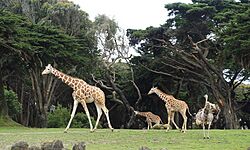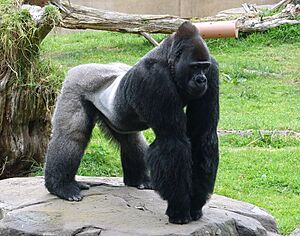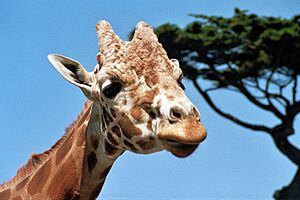San Francisco Zoo facts for kids
 |
|

African Savannah
|
|
| Location | San Francisco, California |
|---|---|
| Land area | 100 acres (40 ha) |
| Coordinates | 37°43′59″N 122°30′11″W / 37.73306°N 122.50306°W |
| No. of animals | 1000+ (2015) |
| No. of species | 250+ (2015) |
| Memberships | AZA |
| Major exhibits | African Savanna, Gorilla Preserve, Grizzly Gulch, Primate Discovery Center (Lemur Forest), Cat Kingdom, Penguin Island, Red Panda Treehouse, Insect Zoo |
The San Francisco Zoo is a 100-acre (40 ha) zoo located in the southwestern corner of San Francisco, California, between Lake Merced and the Pacific Ocean along the Great Highway. The SF Zoo is a public institution, managed by the non-profit San Francisco Zoological Society, a 501(c)(3) organization. under a public-private partnership since 1993, receives $4.2 million annually from the city. As of 2016, the zoo housed more than one thousand individual animals, representing more than 250 species. It is noted as the birthplace of Koko the gorilla, and, from 1974 to 2016, the home of Elly, the oldest black rhinoceros in North America.
The zoo's main entrance (one located on the north side across Sloat Boulevard and one block south of the Muni Metro L Taraval line) is to the west, on the ocean side.
Contents
History
Originally named the Fleishhacker Zoo after its founder, banker and San Francisco Parks Commission president Herbert Fleishhacker, planning for construction began in 1929, on the site adjacent to what was once the largest swimming pool in the United States, the Fleishhacker Pool. The area was also already home to a children’s zoo and playground, an original (circa 1921) Michael Dentzel/Marcus Illions carousel, and the Mother’s Building, a lounge for women and their children. Most of the exhibits were populated with animals transferred from Golden Gate Park, including two zebras, a cape buffalo, five rhesus monkeys, two spider monkeys, and three elephants (Virginia, Marjorie, and Babe).
The first exhibits built in the 1930s cost $3.5 million, which included Monkey Island, Lion House, Elephant House, a small mammal grotto, an aviary, and bear grottos. These spacious, ha-haed enclosures were among the first bar-less exhibits in the country. In 1955, a local San Francisco newspaper purchased Pennie, a baby female Asian elephant, and donated her to the zoo after many children donated their pennies, nickels, and dimes for her purchase.
The zoo has faced decades of scrutiny over the it’s safety protocols, animal care practices and management. Criticism extended to Zoo Director Tanya Peterson, whose leadership has been questioned over alleged mismanagement and animal care practices. Incidents, including the theft of a squirrel monkey and lemur, the death of a young gorilla due to a hydraulic door malfunction, and a radio spying controversy, fueled concerns about the zoo's operations. Additionally, violations of local laws and a breach of contract regarding public access to operational information were reported. Amidst ongoing criticisms, the zoo faced incidents like a mountain lion killing marsupials and a grizzly bear escaping primary containment, prompting continued scrutiny and calls for improved management and animal welfare practices.
Over the next forty years, the Zoological Society became a powerful fundraising source for the San Francisco Zoo, just as Fleishhacker had hoped when he envisioned: "…a Zoological Society similar to those established in other large cities. The Zoological Society will aid the Parks Commission in the acquisition of rare animals and in the operation of the zoo." True to its charter, the Society immediately exerted its influence on the zoo, obtaining more than 1,300 annual memberships in its first ten years (nearly 25,000 today). It also funded projects like the renovation of the Children’s Zoo in 1964, development of the African Scene in 1967, the purchase of medical equipment for the new zoo Hospital in 1975, and the establishment of the Avian Conservation Center in 1978.
In November 2004, Tinkerbelle, San Francisco Zoo's last Asian elephant, was moved to ARK 2000, a sanctuary run by PAWS-Performing Animal Welfare Society located in the Sierra Nevada foothills. She was later joined in March 2005 by the African elephant Lulu, the last elephant on display at the zoo. The moves followed the highly publicized deaths of thirty-eight-year-old Calle in March 2004, and forty-three-year-old Maybelle the following month.
In early 2006, the SF Zoo announced its offer to name a soon-to-hatch American bald eagle after comedian Stephen Colbert. The publicity and goodwill garnered from coverage of the event on the Colbert Report was a windfall for the zoo and the city of San Francisco. Stephen Jr. was born on April 17, 2006.
Exhibit renovations
|
|
Animals and exhibits
Indian peafowl roam the zoo grounds freely. The zoo also has Chilean flamingos.
African Region
Leanne B. Roberts African Savanna
- Grant's zebra
- Common ostrich
- Reticulated giraffe
African Aviary
- Blue-bellied roller
- Hadada ibis
-
Hamerkop
 Gorilla at San Francisco Zoo
Gorilla at San Francisco Zoo - Long-tailed glossy starling
- Northern bald ibis
Jones Family Gorilla Preserve
Doelger Primate Discovery Center
- Coquerel's sifaka
- Fossa
- François' langur
- Gray fox
- Mandrill
- Red-footed tortoise
- Yellow-crowned amazon
Lipman Family Lemur Forest
- Black-and-white ruffed lemur
- Blue-eyed black lemur
- Crowned lemur
- Red-bellied lemur
- Red-fronted lemur
- Ring-tailed lemur
Great Ape Passage
Cat Kingdom
- African lion
- Black rhinoceros
- Eastern bongo
- Indian rhinoceros
- Jaguar
- Komodo dragon
- Ocelot
- Pygmy hippopotamus
- Snow leopard
- Wolverine
Penguin Island
Outback Trail
South America
Puente al Sur
South American Tropical Rainforest and Aviary
- Amazon tree boa
- American white ibis
- Blue-headed macaw
- Blue-throated piping guan
- Blue-winged teal
- Boa constrictor
- Crested oropendola
- Curl-crested aracari
- Dyeing poison dart frog
- Emerald tree boa
- Golfodulcean poison frog
- Great curassow
- Green anaconda
- Green and black poison dart frog
- Honduran spiny-tailed iguana
- Linnaeus's two-toed sloth
- Northern caiman lizard
- Panamanian golden frog
- Plumed basilisk
- Red-eyed tree frog
- Red-footed tortoise
- Red-lored amazon
- Roseate spoonbill
- Ruddy duck
- Scarlet ibis
- Smoky jungle frog
Bear Country
Exploration Zone
Conservation
Two black bears were rescued as orphans in Alaska. The male was found on the edges of town near Valdez in May 2017 and the female cub was found near Juneau in June 2017. Both cubs were determined by the Alaska Department of Fish and Game to be motherless and were brought to Alaska Zoo and rehabilitated back to health. In 2017, the Alaska Zoo had more orphaned bear cubs than ever before, due to the repeal of bear hunting regulations by the Trump administration, which allowed for the hunting of hibernating bears in their dens. Mr. Lampi said. The two bears were brought to the San Francisco Zoo in 2017 and a previously empty habitat was repurposed to host them.
The zoo housed Henry, a 10-year-old blind California sea lion who was found stranded on a beach in Humboldt County in 2010. In 2012, he was brought to the San Francisco Zoo, he was treated by veterinarians for his blindness.
Species survival projects
The San Francisco Zoo participates in Species Survival Plans, conservation programs sponsored by the Association of Zoos and Aquariums. The program began in 1981 for selected species in North American zoos and aquariums where the breeding of a species done to maintain healthy, self-sustaining, genetically diverse and demographically stable populations. The zoo participates in more than 30 SSP programs, working to conserve species ranging from Madagascan radiated tortoises and reticulated giraffes to black rhinos and gorillas.
See also
 In Spanish: Zoológico de San Francisco para niños
In Spanish: Zoológico de San Francisco para niños
- Citizens Lobbying for Animals in Zoos


